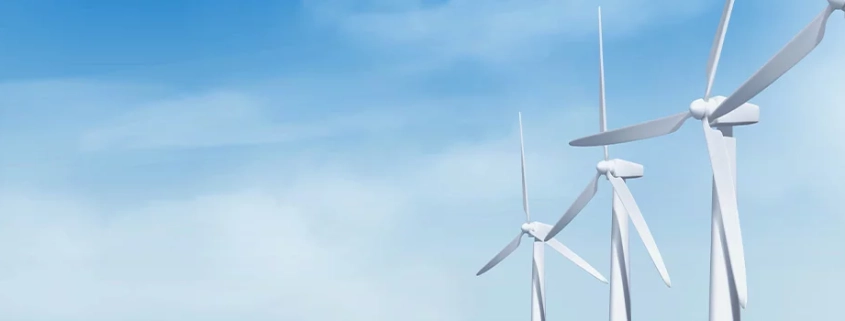Fall Protection in the Wind Energy Industry
Wind energy is one of the most promising and sustainable sources of renewable energy that can meet the increasing energy needs of our society. Wind turbines, also known as aircraft engines, provide clean electricity and are a major contributor to the global fight against climate change. However, maintenance and repair operations involve working at heights, exposing operators to a high risk of falls (potentially fatal). Therefore, fall protection equipment plays an important role in ensuring their safe intervention.
Wind energy in France
In France, wind energy is becoming an increasingly important part of the country's energy growth in terms of green energies. It is an integral part of France's efforts to promote renewable energy sources and reduce its dependence on fossil fuels. It is a major player in electricity production in France.
According to EDF, in 2019 renewable energies represented 20.2% of the energy produced in the country. This sector therefore represents the second largest source of renewable energy, just behind hydropower, with 34.1 TWh (terwatt-hours). This figure should continue to increase as new wind farm projects are developed and awareness of the importance of climate change increases.
Additionally, these generators are likely to play an increasingly important role in France, as the French government aims to promote this type of energy. Therefore, it has introduced various support policies to promote this type of energy. These include guaranteed feed-in tariffs for wind-generated electricity, calls for proposals for project development, and tax incentives and subsidies for developers.
Wind farms are most often located in areas with favorable conditions, that is, areas with regular winds strong enough to produce electricity efficiently. Coastal regions and mountainous areas often present suitable criteria for the construction of wind farms. There are both land-based (onshore) and sea-based (offshore) wind farms.
Features of onshore wind turbines:
- Power: 1.8 to 3 MW (megawatts)
- Height: 120 to 155 m
Features of offshore wind turbine:
- Power: about 15MW
- Height: 157 m above sea level
Fall protection equipment for wind turbines
Work on wind turbines often involves significant heights where a fall of even a few meters can cause serious injury or death. The use of fall protection systems such as seat belts, lifelines and restraint systems significantly reduces the risk of fatal accidents. In case of slipping or loss of balance, this equipment restrains operators and prevents free fall. Seat belts are essential PPE for working at heights, such as on wind turbines. There are also self-retracting reels (also known as “fall arresters”).
Compliance with security standards
Wind energy industries are subject to strict safety regulations, especially those related to working at height. Fall protection equipment is an essential regulatory requirement as it plays an important role in complying with current safety standards . By investing in this equipment, companies in the industry demonstrate their commitment to protecting the lives of their employees.
Worker safety is a fundamental aspect of the industry's overall image. By implementing strict safety protocols and providing adequate protective equipment, the industry strengthens its reputation as a responsible player that cares about the well-being of its employees. This can also help attract talented and dedicated talent.
Safety standards for work on wind turbines are defined to prevent accidents, minimize risks to workers' health and ensure a safe working environment. These standards are usually set by national or international regulatory authorities and are based on extensive research and industry best practices. Some specific aspects of safety standards regarding fall protection in the wind energy sector are:
Regulations require that the equipment used be certified in accordance with existing rules and regulations. These include seat belts, lifelines, energy absorbers and connectors. This equipment should be regularly inspected, maintained and replaced if necessary. The standards for safety belts are: EN 361 (PPE against falls from heights: fall arrest belts), EN 358 (PPE for work positioning and prevention of falls from heights: support and restraint belts and support straps), EN 813 (PPE for the prevention of falls from heights in suspension: seat belts), EN 1497 (PPE against falls from height with rescue buckles: rescue belts).
Numerous other regulations also need to be taken into account, such as standards for connection, energy absorption and anchoring systems (EN 353-1, 353-2, 354, 355, 360, 362, 795).
Workers performing work at height must also be properly trained in the proper use of fall protection equipment, safety procedures specific to wind turbines, and fall prevention. They must be certified as competent to perform these duties. It is important to be able to assess potential risks and know how to properly handle a dangerous situation.
The regulations specify requirements for the design and installation of fall protection systems. These include determining appropriate anchorage points, the strength of the materials used, and configuring lifelines to ensure effective protection.
To ensure the maximum safety of these employees, the equipment used must be checked regularly.
In today's booming wind energy industry, worker safety must be an absolute priority and fall protection equipment plays a vital role in protecting workers when working on infrastructure at significant heights. By investing in safety, the wind industry is demonstrating its commitment to its workers and helping shape a safer, more sustainable energy future.



